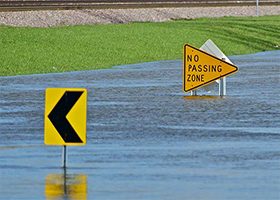


The Intact Centre surveyed 103 government representatives, who self-assessed preparedness to limit flood damages relative to current and future major rainfall events across 12 categories of evaluation. The overall score for provinces and Yukon was C-, indicating room for improvement to better prepare for and mitigate against flood risk.
The categories of evaluation included flood-plain mapping, land-use planning, drainage systems maintenance, sustainable flood management, home and commercial flood risk audits, transportation and electricity supply, water and wastewater systems, public health and safety, and emergency preparedness and response. Great variability in responses to the majority of categories assessed suggested a lack of a standardized approach and coordination on flood risk mitigation in Canada.
So why should pension funds be concerned?
As an investor, pension funds carry real estate and infrastructure assets, energy stocks and municipal bonds. All can be adversely affected by not only the physical damage caused by flooding, but also by the escalating economic impacts associated with these catastrophic events.
Devaluation of property values is already a reality for areas where severe and repeated flooding persists. The availability of affordable insurance is diminished in areas prone to or ill-prepared to respond to flooding. Often, the impacts of flooding are wide-reaching, affecting supply chains through disruptions in raw material availability and transportation delays. These disruptions can have global impacts (e.g., global price hikes).
As the cost of more severe and frequent floods in Canada rises, the economic stability of the country is threatened.
With Canada’s provinces and Yukon not quite stepping up to the challenge to prepare and respond to these threats proactively, the risk is passed on to everyone else — including pension investors.
Insurance and reinsurance rates will rise to reflect this increased risk with some re-insurers suggesting that a higher frequency of billion-dollar-plus events, such as the Toronto and Calgary floods in 2013, and the Fort McMurray 2016 wildfire, make it increasingly difficult to think of Canada as a “safe diversifier” of risk.
Thus, the cost will be passed on to the consumers of insurance, including pension funds, who buy insurance to protect their real assets and associated investment income.
Buying insurance does not equate to actively managing risk. For example, during the Fort McMurray wildfire, several large oil companies had to shut down operations, leading to $70 million per day in lost revenues. Only a few months after the wildfires were controlled, torrential rain flooded parts of the city, raising concerns that rebuilding efforts would be delayed. In June, flooding in northeastern B.C. caused shut downs at Pine River Gas Plant. This translated to a 10% interruption of gas production for Canadian Natural Resources Ltd., Canada’s largest gas producer.
As extreme weather introduces a significant concern to operational resiliency, there is mounting pressure on institutional investors to assess, evaluate and disclose their exposure to extreme weather risks and potential impacts to portfolio value. These investors need to take an active role in mitigation of climate risk and invest in adaptation.
So, what can pension funds do about extreme weather risks?
Pension funds are dependent on the resilience of the assets and the cities in which they operate.
Sufficient data and technology solutions are available to identify areas of weak preparedness and to assess the possible financial impact of extreme weather events on single assets or entire portfolios. This type of portfolio risk assessment can be completed on existing portfolios of assets and on new or prospective acquisition targets.
Is your portfolio at risk?
The first step in risk assessment is to determine the allocation of portfolios in high risk areas. This risk assessment is akin to developing a heat map against which investment allocation data can be superimposed. This is routinely done by insurance and reinsurance providers for risks such as earthquake and flood.
Investors can then review their portfolio risk allocation with a specific lens to determine the following:
- Location risk: What level of inherent extreme weather risk exists where you invest and how will the jurisdiction respond to this risk? What level of extreme weather risk exists across the supply chain?
- Asset resiliency: What is the inherent or engineered tolerance of the assets you own or invest in?
- Demographic resiliency: Will the community in which you operate and invest withstand recover and continue to thrive after the event and at what level?
The economic value of risk exposure can then be determined for each investment and its impact measured against the original risk tolerance that was used to select the investment. Each fund does this a little differently but, at a basic level, one can estimate the maximum loss an investment asset can absorb in yield, capitalization rate or investment income.
Once the risk and impact of risk are identified, appropriate risk mitigation and risk treatment can be evaluated for effective implementation. This includes determining any opportunities to invest in adaptation strategies that may reduce the impact of loss to acceptable levels.
More importantly, investors have a fiduciary duty to protect the investment value from undue risks.
It is no longer acceptable to claim extreme weather as an unforeseen “act of God”. Therefore, extreme weather risks, including flooding, should be included in the stress testing of any current and future investments – this is a pension fund’s fiduciary responsibility.
As large and long-term investors, pension funds are in a unique position to drive climate change mitigation and adaptation efforts worldwide. Capital markets as a whole can do better by assessing climate risk and delivering investments in infrastructure projects that will better perform in the face of future events, making cities more resilient, and in the clean energy transition to mitigate the ongoing effects of carbon emissions on climate.
Natalia Moudrak is Director, Intact Centre on Climate Adaptation. Tania Caceres is Principal, Risk Nexus.
